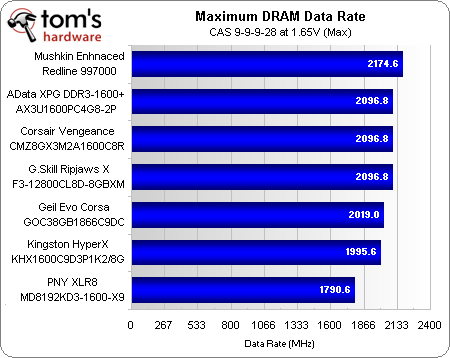Seven 8 GB DDR3 Memory Kits For Your AMD A75 Motherboard
Because integrated GPUs generally employ shared system memory, RAM performance has a significant effect on gaming frame rates. We're testing seven 8 GB DDR3 kits that manufacturers tell us are a perfect match for AMD’s mainstream Llano-based APUs.
Benchmark Results: Latency And Overclocking
| Best Timings at 1.60 V | |||
|---|---|---|---|
| Row 0 - Cell 0 | DDR3-1866 | DDR3-1600 | DDR3-1333 |
| Mushkin Enhnaced Redline 997000 | 8-9-5-15 | 7-8-5-15 | 6-6-5-15 |
| Adata XPG DDR3-1600+ AX3U1600PC4G8-2P | 8-9-6-16 | 7-8-5-15 | 6-6-5-15 |
| G.Skill Ripjaws X F3-12800CL8D-8GBXM | 8-9-6-16 | 7-8-5-15 | 6-6-5-15 |
| Corsair Vengeance CMZ8GX3M2A1600C8R | 8-9-8-15 | 7-8-5-15 | 6-6-5-15 |
| Kingston HyperX KHX1600C9D3P1K2/8G | 8-10-5-15 | 7-9-5-15 | 6-6-5-15 |
| Geil Evo Corsa GOC38GB1866C9DC | 8-10-6-15 | 7-8-5-15 | 6-6-5-15 |
| PNY XLR8 MD8192KD3-1600-X9 | 11-11-6-15 | 9-10-5-15 | 8-8-5-15 |
Most of today’s modules only required 1.50 V to operate at their rated settings, but a few were designated 1.65 V designs. Without a proven track record for over-volting the memory controller of AMD’s 32 nm Llano APU, we decided to play it safe at 1.60 V. One of the 1.65 V-rated kits still took first place, as Mushkin’s Redline 997000 reached incredibly low 8-9-5-15 timings at a high DDR3-1866 data rate.
We never thought ASRock’s minimum tRAS of 5 would be a restrictive factor in our memory tests, but AMD’s new memory controller and the high-quality ICs used on today’s top modules combine to facilitate surprising low-latency capabilities.
Mushkin also wins the overclocking competition, though the top six of seven kits finished so close together than we have to wonder how much of today’s results are due to luck, and how much is due to custom binning by memory manufacturers.
Get Tom's Hardware's best news and in-depth reviews, straight to your inbox.
Current page: Benchmark Results: Latency And Overclocking
Prev Page Test Settings Next Page DDR3-1866 Benchmark Results-
hmp_goose Where's the CAS7 DDR3-1333? Many of us are still trying to pin down how important timing are in the scheme of things …Reply -
whysobluepandabear hmp_gooseWhere's the CAS7 DDR3-1333? Many of us are still trying to pin down how important timing are in the scheme of things …Reply
They're not.
You're better off buying value RAM with decent timings and throwing that extra $$$ into a GPU. I promise your FPS will improve more that way.
-
Crashman Reply
CAS 7? Most of the modules were tested at DDR3-1333 CAS 6.9519239 said:Where's the CAS7 DDR3-1333? Many of us are still trying to pin down how important timing are in the scheme of things …
http://www.tomshardware.com/reviews/llano-apu-memory-performance,3017-10.html
Please read the article, thanks! -
Rizlla I have been looking at those Corsair kits for an upgrade and it's good to know they are approved.Reply -
beenthere As has been known for quite some time, there is virtually no performance gain on DDR3 RAM with lower CAS because DDR3 has plenty of bandwidth and frequency. The higher the frequency the lower the cycle time in real time, thus CAS 7 vs. CAS 9 is totally insignificant in system performance.Reply -
ojas Is it a valid conclusion that, if the 8GB kits are good, then the corresponding 4GB and 2GB kits would be good to? Or will pricing make a difference there?Reply -
ChromeTusk Reply
Wish I found that Corsair CAS8 kit, but I did find the CAS9 version for $50, no rebate or shipping.9519243 said:I have been looking at those Corsair kits for an upgrade and it's good to know they are approved. -
nforce4max I bought the cheaper version G.SKill kit for $59 oh well :s can't wait for prices to drop again for a little splurge ;)Reply -
-Fran- Nice review guys!Reply
I got the HyperX modules the A8 and the Vengeance are on my main rig. Now, I'm still intrigued about unganged when using a 4 module MoBo. I got the A8 with 4 modules in unganged at 1600 CL9 and it runs pretty well, but i wonder how that compares to this 2 modules MoBo.
Cheers!

